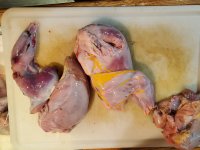GetTothePoint
Well-known member
So I've finally seen enough that I'm going to ask. I'm going on a few years of having to travel to SD for my bird hunting fixes because I'm fed up with KS wildlife department. The first year I noticed that when I clean birds the fat looks different from SD to KS. KS birds have thick yellow fat while the heavy, heavy majority of SD birds have what I would say is thinner whitish fat? This year is the first year I've hunted late season up north and while we have shot some mature birds with big tails, leading me to believe they're wild, they still have the white thin fat? Is it a genetic difference or are we really hunting that many turned out birds? I don't know their turnout protocol but I can't imagine the area I go and the places I hunt would be high on the list of stocking birds. I'm not bashing anything, I appreciate SD efforts for upland, but is really starting to make me wonder?

